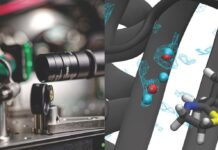A group of researchers from the University of Chicago, led by Professor Cheng Chin, ultra cooled down a gas of atoms synthesizing, for the first time, a superfluid of molecules.
A superfluid is a rare state of nature where a substance suddenly flows without apparent friction, allowing it to seep through tiny pores where regular fluids can’t. Superfluids even seem to defy gravity, climbing container walls as if they wanted to free themselves.
In their article published on the 28th of April in Nature, Chin and collaborators explained that they cooled down thousands of cesium atoms to one-billionth of degrees Celsius above absolute zero, creating a Bose-Einstein condensate.
What is a Bose-Einstein condensate?
Atoms in a gas usually are in different quantum states. To grasp what this means, imagine a quantum state as a “barcode” that encapsulates quantum properties. Each atom in a gas is labeled with a set of quantum properties in its own “barcode”.
When these atoms are cooled down, achieving the Bose-Einstein condensate, all of them get exactly the same “barcode”, or the same set of quantum properties simultaneously.
Another way of understanding this is by considering the wave nature of atoms. Usually, each atom will behave as an “independent wave”. In a Bose-Einstein condensate, those atoms behave collectively as a single wave.
In Chin and collaborators’ experiments, once the Bose-Einstein condensate was achieved, they forced the atoms to move only in two directions, like in a film. Then, they turned on a magnetic field transverse to that film. Under these conditions, the cesium atoms reacted by forming pairs behaving as a superfluid of molecules.
This state of nature is called Bose-Einstein after the Indian theoretical physicist Satyendra Nath Bose and Albert Einstein, who proposed its existence in the early 20s of the last century.
It was not until the 90s when scientists succeeded in creating a Bose-Einstein condensate of atoms in the laboratory. For this breakthrough, Eric A. Cornell, Wolfgang Ketterle, and Carl E. Wieman were honored with the Nobel Prize in Physics in 2001.
If producing a phase transition to this quantum state of nature in atoms was challenging, it is even harder for molecules. Molecules vibrate, rotate; they are complex to handle.
In Bose-Einstein condensate, molecules “sing at unison”: they have the same energy, vibrate and rotate exactly in the same way. “In the traditional way to think about chemistry, you think about a few atoms and molecules colliding and forming a new molecule,” Professor Chin explained.
Advances in Bose-Einstein condensation with molecules will open new frontiers of research in chemistry. Scientists will be able to control chemical reactions at a quantum level. It could also help create a new branch in the field of quantum information and even push forward our understanding of quantum mechanics itself.
References
Zhang, Z., Chen, L., Yao, K., and Chin, C. (2021). Atomic Bose-Einstein condensate to molecular Bose-Einstein condensate transition. Nature 592, pages 708–711. DOI: 10.1038/s41586-021-03443-0.
Full text available in the preprints arxiv.
Illustration: Dana Dumea





